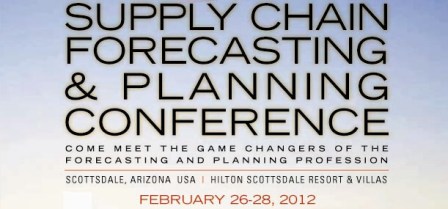There is less than two weeks before the IBF Supply Chain Forecasting & Planning Conference in Scottsdale, AZ (February 26-28). The annual IBF Golf Outing is on Sunday, February 26.
I myself am not a big fan of the sport (It costs too much, takes too long, and requires way too much social interaction). But I did catch a little bit of the Pebble Beach Pro-Am on TV yesterday, and to my surprise I saw something strikingly relevant to forecasting.
After someone hit a particularly good or bad shot off the tee, the commentators went on to provide analysis of the swing. This involved a super-slow motion replay, complete with brilliant observation and sage explanatory analysis. It was amazing — just by looking at a bend of the knee, a twist of the hips, a shift in weight, and the arc of the club head — the commentators could tell you exactly why the shot did what it did. (Of course, I’m sure it helped that they had already seen what the shot did before they watched the slo-mo replay and concocted the explanation.)
Why is this Relevant to Forecasting?
As Forecasters it can be quite easy to look back in time and explain why something happened? This is exactly what we do when “fitting” a model to historical information. We observe behavior that has already occurred (whether it be a golf shot, or weekly sales), and then proudly assert the reasons why it happened the way it did.
Forecasting is about what is going to happen in a future we haven’t yet seen. It is no coincidence that the “fit” of a model to history can have little relationship to the accuracy of the forecasts. Just like the commentator can provide a perfect explanation for a golf shot he has already observed, we can always find a perfect fit to historical sales (or whatever else we are trying to forecast). While fitting to history should be a consideration in building a forecasting model, it should not be the sole consideration.
We’ll examine this, along with other worst practices in business forecasting, at the round table sessions on Monday afternoon at the conference in Scottsdale. Ryan Rickard (of Newell Rubbermaid) and I will also touch on worst practices in our ½ day workshop on Monday morning, “What Management Must Know About Forecasting.” The workshop has three sections:
- Review of fundamental forecasting issues like definition of demand, forecastability, demand volatility, accuracy expectations, and evaluating performance.
- Step-by-step instructions for conducting Forecast Value Added analysis, including data collection, data analysis, and reporting.
- Case study on how Newell Rubbermaid is applying these approaches.
While at the event, be sure to pick up a free copy of The Business Forecasting Deal at my book signing during breakfast on Tuesday.
Hear Mike Speak at IBF’s:



